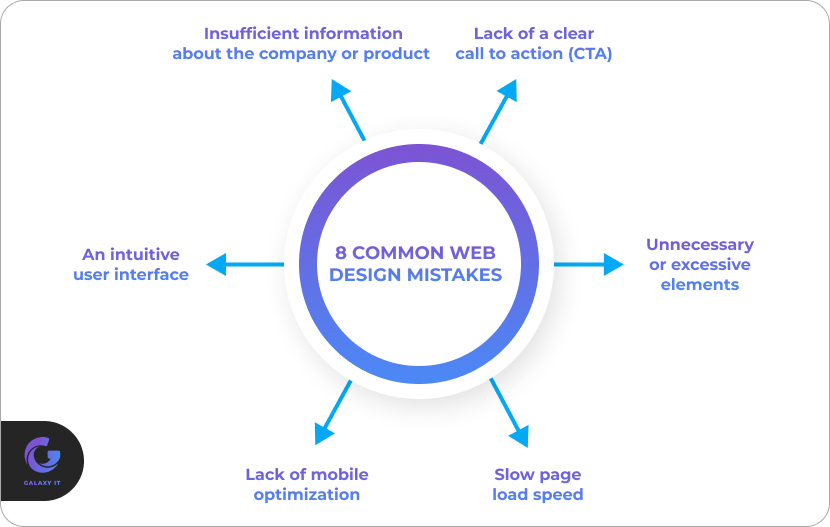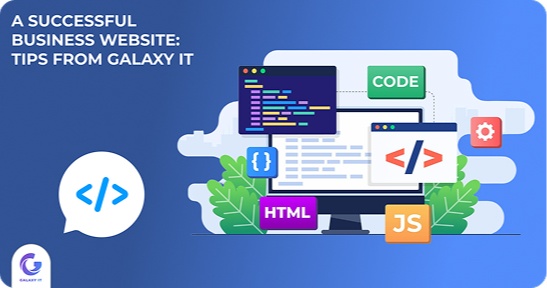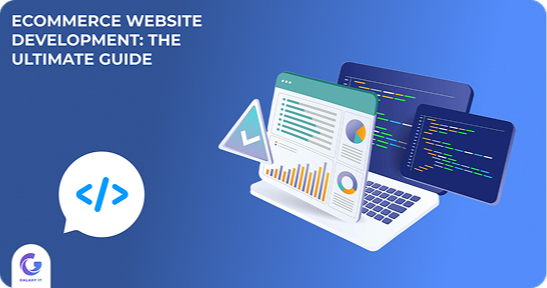8 common web design mistakes to avoid in 2025 for a better user experience
- 30.05.2025
- 3 views
- 17 min
- Did you know that 75% of trust in your website depends on its design?
- 1. An intuitive user interface
- 2. Lack of mobile optimization
- 3. Slow page load speed
- 4. Unnecessary or excessive elements
- 5. Lack of a clear call to action (CTA)
- 6. Incompatibility with browsers
- 7. Mismatch with brand and style
- 8. Insufficient information about the company or product
- Conclusion
Did you know that 75% of trust in your website depends on its design?
Web design plays a critical role in building trust with your audience. Whether you’re running an e-commerce site or a business blog, the design of your website can influence how visitors perceive your brand and, ultimately, whether they choose to become customers. Bad design choices can harm user experience, resulting in lost leads and lower conversions. To help you avoid common pitfalls, we’ve compiled a list of the 8 most common web design mistakes to steer clear of in 2025. By making the right design choices, you can enhance user trust and drive better results for your business.

1. An intuitive user interface
A user-friendly interface is essential for providing a positive experience on your website. If visitors struggle to navigate through your site, they’re more likely to leave, hurting your site’s conversion rate.
- Why it matters: A confusing or complex navigation system can frustrate users, causing them to abandon your site. An intuitive layout ensures that visitors can quickly find what they need, whether it's information about your products or your contact details.
- Tip: Keep the design simple and ensure that key information is easy to locate. Test the navigation with users to ensure they understand where to go without confusion.
2. Lack of mobile optimization
With over half of web traffic coming from mobile devices, mobile optimization is no longer a luxury — it’s a necessity. Sites that don’t cater to mobile users risk losing a significant portion of their audience.
- Why it matters: A non-responsive website doesn’t just look unprofessional—it can lead to a high bounce rate. Without mobile optimization, users will have to zoom in or scroll sideways to view your site, which will create a frustrating experience.
- Tip: Ensure your site is fully optimized for mobile devices. Responsive design should adjust the layout and content to suit any screen size. Check mobile site performance on various devices to avoid unnecessary scrolling or distorted images. Regularly test and optimize for mobile-first design.
3. Slow page load speed
Page load speed is one of the most crucial aspects of website optimization. A delay of just a few seconds in loading can result in a high abandonment rate.
- Why it matters: Slow-loading pages directly affect the user experience, making visitors more likely to leave before the page fully loads. Additionally, search engines like Google rank faster sites higher, so slow speeds can negatively impact your SEO.
- Tip: Run speed tests and optimize your images, scripts, and third-party apps to improve load time. Tools like Google’s PageSpeed Insights can help identify bottlenecks and offer recommendations for improvement.
4. Unnecessary or excessive elements
Cluttered websites with too many visual elements can overwhelm users, reducing their ability to focus on the most important information.
- Why it matters: Excessive design elements like too many pop-ups, large banners, or irrelevant animations distract from your message and create a frustrating browsing experience.
- Tip: Simplify your design. Focus on what’s essential for your users and remove elements that don’t contribute to the overall experience. Using minimalistic design principles and testing with user feedback can help you create a cleaner, more efficient website.
5. Lack of a clear call to action (CTA)
CTAs are pivotal in guiding your users toward the next step in their journey, whether it’s making a purchase, signing up for a newsletter, or requesting a demo.
- Why it matters: A weak or unclear call to action can confuse visitors and prevent them from taking desired actions. Without a clear CTA, even well-optimized sites can fail to convert visitors into leads or customers.
- Tip: Make CTAs visible, compelling, and specific. Use action-oriented language like “Get Started,” “Contact Us,” or “Download Now.” Position them strategically throughout your site to ensure they’re easily accessible. A well-designed CTA button with contrasting colors can make a significant difference.
6. Incompatibility with browsers
Not all browsers are created equal, and browser compatibility issues can cause significant design and functionality problems for users.
- Why it matters: Your site should work seamlessly across all browsers, from Chrome to Safari to Firefox. Incompatibility with browsers can cause design elements to break or features to malfunction, which may negatively impact your brand’s credibility.
- Tip: Regularly test your site on multiple browsers to ensure compatibility. Using cross-browser testing tools can help identify and address issues before your site goes live. It’s important to keep your website updated with the latest standards to ensure consistent performance across all platforms.
7. Mismatch with brand and style
Your website design should reflect your brand’s identity. Branding in web design is about conveying your company’s values, mission, and style through visual elements.
- Why it matters: A design that doesn’t align with your brand can confuse visitors, reduce trust, and make your site feel disconnected. Consistent branding fosters a sense of professionalism and builds trust with your audience.
- Tip: Keep your color palette, typography, and imagery consistent with your brand guidelines. Ensure the visual tone matches your brand’s personality—whether it’s sleek and modern, warm and welcoming, or fun and creative. Inconsistent design elements can harm customer trust.
8. Insufficient information about the company or product
Your website should provide clear, concise, and easy-to-find information about your business and offerings. A lack of detailed information can lead to missed opportunities for conversions.
- Why it matters: Users who can’t easily find product descriptions, pricing details, or company information will likely abandon your site. Providing clear, relevant content builds trust and boosts engagement.
- Tip: Include comprehensive yet straightforward information about your services, products, and company values. Use screenshots and examples to show how your products work and provide easy access to your contact information. Ensure that product pages are easy to navigate, with user-friendly layout and functionality.
Conclusion
Avoiding these common web design mistakes will help you create a website that not only looks great but also provides an excellent user experience. Whether it’s focusing on website optimization, improving page load speed, or ensuring mobile site compatibility, every detail counts in keeping your visitors engaged. By investing time and resources in branding in web design and user-friendly features, you can drive better results for your business in 2025.
Need assistance with designing or optimizing your website? Contact us for consultation at Galaxy IT. We’re here to help you craft the perfect website experience for your brand








